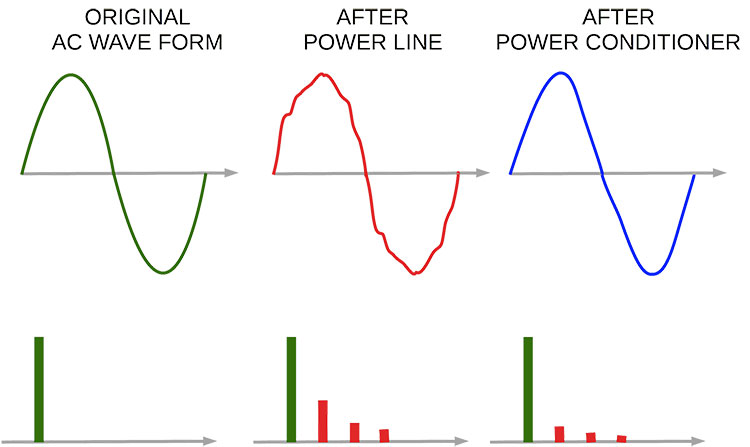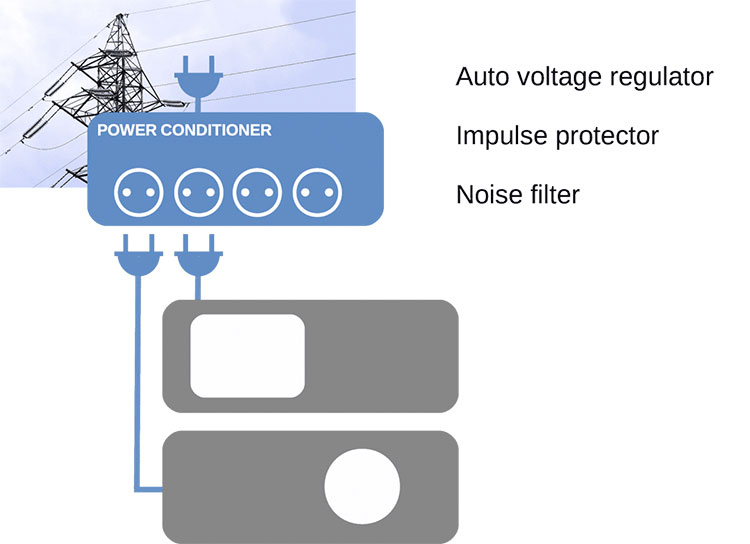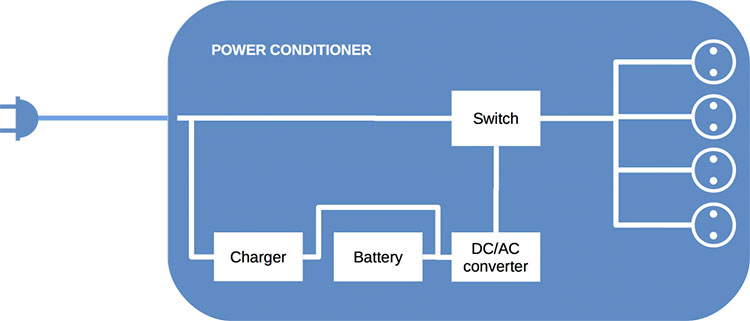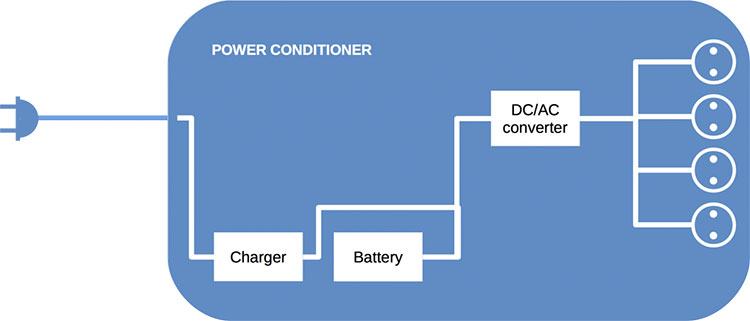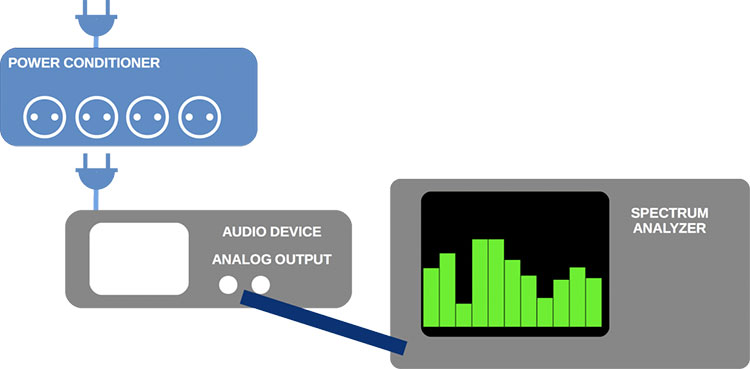A power conditioner is a piece of equipment whose electrical functionality is relatively simple to demonstrate. However, what is harder is measuring the conditioner’s impact on sound quality. This topic will look at what happens with audio playback with and without the use of power conditioning.
I’d want to tell you right now: there is no simple unequivocal answer. Each case is individual. At each home or studio setup, personal setups will affect the outcome. There are many variables. I suppose, even careful big research results do not cover all cases.
Abbreviations
Using A Power conditioner
An ideal alternating current’s electrical waveform is a pure sine. Distortions and ambient noise are added to the sine in a wire spread. Electrical motors, transformers, and other sources generate pulses when this equipment is switched. “Dirty” alternating current come from electrical outlets directly into audio devices such as amps.
In general
Electrical power conditioning
In the picture, waveforms (top) and spectrums (bottom) are shown. Waveforms and spectrums are not real and are intended for demonstration purposes only. A PWC is connected to an electrical network outlet. Audio devices are connected to output outlets of PWC for a higher qualitative power supply.
At the PWC’s output outlet, alternating current is filtered (purer sine). The current is intended to feed heterogeneous home equipment such as DACs and amps.
Power conditioner uses
- Auto voltage regulation is a very desirable functionality for audio equipment which may be sensitive to the voltage out of an allowable range.
- Impulse protector which protects audio equipment against damage by large voltage pulses into the network.
- The noise filter removes different air (caught on wires) and other interference.
- Also, an isolation transformer may be used for electrical noise suppression via galvanic isolation of the AC circuits. The transformer breaks so-called ground loops, causing additional currents (we can consider it noise) in the line. The transformer, as a coil, may improve surge suppressing theoretically.
- The conditioner may remove a constant part of the input voltage that may cause additional heating of the electrical transformers in an audio device power supply unit.
From the above, you will notice that there is no standard definition of a “power conditioner”. Conditioners may be considered various devices ranging from pulse protectors, and auto voltage regulators to very sophisticated uninterrupted energy sources with the synthesis of an output voltage in a sine form.
So conditioners may have different functionalities. If you choose the conditioner, check its specification first to see if it matches your requirements.
How power noise could affect sound quality
Sound quality can be determined in part by the level of noise and distortion at the analog output of an audio device. Theoretically, noise from AC can penetrate the audio output and add noise and/or modulation of the audio signal.
Below we will learn an audio system structure we need to get a better understanding of how it can work.
Noise spreading in home and studio audio systems
Noise is spread in 2 ways:
- electrical power wires (more significant way),
- air.
Electrical noise spread
Power conditioned system structure
First, let’s consider the simplest system: the conditioner feeds a single device.
Power system structure
“Dirty” electrical voltage comes to the conditioner from the AC power line. Impulses with big voltage are suppressed by an impulse protector. This protection prevents electrical damage to the audio device.
An auto voltage regulator tries to normalize long-term voltage changes. The noise filter suppresses other types of noise such as electromagnetic interference (EMI).
In emergency cases (super high voltage levels or extremely low quality) the conditioner can break the connection with the input line. It defends the audio device and the conditioner against damage.
Power conditioners can synthesize a sine output voltage. Or output voltage may have a waveform close to a square.
The PWC may have an internal accumulator battery. In emergency cases, the conditioner may switch the audio device’s supply to the battery’s DC/AC converter. Such PWCs are called uninterrupted power sources (UPS).
The approximate functional design of switched uninterrupted power source
As an alternative, a DC/AC converter can feed audio devices without switching.
The approximate functional design of permanent voltage generation UPS
PWC doesn’t guarantee sine at the conditioner’s outlets. But some models can do it.
It’s important to remember, that it is not a mandatory function of power conditioners. There are many different schemes and decisions. Read carefully PWC’s specification or manual to see if your conditioner has such a function.
Noise spreading via the power supply system
Noise and changes from the power source (for example, your wall AC outlet) pass the conditioner with suppression.
Noise spreading through the power system
A power supply unit (PSU) connects to the audio device and converts high voltage AC to low voltage DC. Noise pass through the PSU partially and enters into the low voltage line (DC).
The power supply unit is also a noise source itself. So there is a need to separate external noise (from AC input) and prevent the PSU from delivering ‘hum’. Further, the cumulative noise can enter either the digital or analog circuit path through the internal DC power buses. So digital paths can also be a noise source as well as analog.
When an audio signal enters the analog path, this part can also affect the low voltage line. Because transistor/tube switching causes currency changes, that may cause power bus voltage changes. Therefore, a power supply system is a complex function with several noise sources and feedback.
Total noise in a low voltage power line (including external AC noise) affects the audio output. So, first, we must check the noise spectrum and level at the analog output of the audio device.
With the measurement of the conditioners’ impact on the sound quality in terms of noise levels, we can compare noise at the analog output with and without the PWC. If the difference is invisible, we can use the conditioner as additional protection against probable surges into the AC network.
As rule a PSU has similar functionality to that of the conditioner, shown in this picture:
- impulse protection,
- auto voltage regulation,
- High-frequency noise filtering.
However:
- some power supply units may have input voltage range issues,
- power conditioners may have a better implementation as an impulse protector.
So the conditioner can provide a more optimal mode for power supply units of audio devices.
Power conditioners may be checked via a special device such as a power line noise meter. You can plug it into the home and conditioner outlets and compare both noise values. If the conditioner works properly, noise at PWC’s outlet will be less than direct to the power line.
This article was first published on http://samplerateconverter.com/educational/power-conditioner.





